
Recent Blog Posts
April 7, 2010
A Diet for Your Genotype?
If you’ve followed my teachings over the years, you’ll know that I believe in taking an individualized approach to nutrition. Simply stated, there is no one diet that is best for everybody. This view is not simply a personal opinion based on anecdotal experience; it’s backed up by a significant amount of research. Studies consistently show that people respond differently to different macronutrient profiles. Here’s an example. A study by Tay and colleagues reported that LDL (i.e. the “bad” cholesterol) levels remained unchanged after subjects consumed a low carb diet over 24 weeks. However, a closer look at the individual responses of participants in the study paints a vastly different picture. Almost 60% of low carb dieters actually showed a reduction in LDL while 24% showed an increase of at least 10%! Such widespread discrepancies can only be attributed to differences in genotype (i.e. the genetic makeup of an individual).

Now, recent research reveals that we may be closer to having an effective tool in customizing diets based on individual response. Data presented at the American Heart Association’s Nutrition, Physical Activity and Metabolism Conference showed that examining the activity of genes involved in fat metabolism can help predict what type of diet is best for a particular person. The researchers used a cheek swab to obtain genetic info on three genes–fatty acid binding protein 2, peroxisome proliferator- activated receptor gamma, and beta 2 adrenergic receptor–then sought to determine response to various diets (i.e. high-carb, low-carb, etc). The verdict? The genes studied had an extremely high correlation as to what diet worked best for the individuals, with those assigned to a the proper diet for their genotype losing up to three times as much weight after a year compared to those who were not assigned to a genotype-appropriate diet.
Now before we get too caught up in numbers, a few things to keep in mind. First, this was just an abstract and the data have not yet been published in a peer reviewed publication. Hence, results need to be interpreted with caution. Second, several of the researchers have a financial interest in the kit used to collect and interpret the info, which has the potential to introduce bias into results. That said, the research was carried out at a very prestigious university (Stanford) and the theoretical basis behind the approach is certainly sound. It will be interesting to see how this plays out, but it represents a potentially exciting development in nutritional science that has important future implications.
In the meantime, the best advice is to experiment with different macronutrient profiles and see how your body responds. A little trial-and-error goes a long way to optimizing a dietary approach that works best for you.
Stay Fit!
Brad
Tay J, Brinkworth GD, Noakes M, Keogh J, Clifton PM. (2008). Metabolic effects of weight loss on a very-low-carbohydrate diet compared with an isocaloric high-carbohydrate diet in abdominally obese subjects. J Am Coll Cardiol. 1;51(1):59-67.
April 2, 2010
The Anti-Aging Benefits of Omega-3s
I’ve discussed the myriad benefits of consuming adequate amounts of omega-3 fatty acids numerous times in this blog. As I’ve detailed previously, the benefits of omega-3s extend to virtually every organ system, and include facilitating loss of body fat. There are few nutritional topics that have as much research-based support.
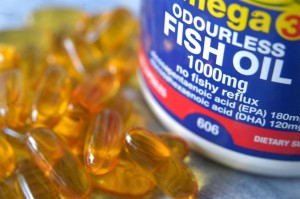
A recent study in the Journal of the American Medical Association (JAMA) sheds some light on how omega-3s may protect against aging. The study looked at the effect of omega-3 intake on telomeres, which are repeat DNA sequences that form a “protective cap” at the ends of chromosomes. It has been previously shown that telomere length degrades over time, exposing cells to early death. This has led researchers to conclude that telomere length may be a marker of health and well being, with shorter telomere lengths associated with premature aging and the onset of cardiovascular disease.
In the JAMA study, researchers examined the relationship between blood levels of omega-3 fatty acids and telomere length in leukocytes (i.e. white blood cells) over a period of five years. Results showed that those who had the lowest levels of omega-3s (as determined by DHA+EPA) showed the greatest telomere shortening while those in the top quartile had the least degree of shortening. This inverse relationship between omega-3s and telomere length lends support to the anti-aging benefits of fish oil consumption. It is yet one more in a long line of studies showing just how important it is to get adequate omega-3s in your diet.
Stay Fit!
Brad
Farzaneh-Far R, Lin J, Epel ES, Harris WS, Blackburn EH, Whooley MA. (2010). Association of marine omega-3 fatty acid levels with telomeric aging in patients with coronary heart disease. JAMA, 20;303(3):250-7.
March 2, 2010
In Support of a Soda Tax…
I generally don’t get political in this blog–after all, my focus is on the science of fitness, not the world of politics. However, a recent issue here in New York has motivated me to take up a cause. Namely, New York governor David Patterson has proposed a tax on soda and other sugary beverages. The tax would encompass soft drinks, energy drinks, sports beverages, and various juices and iced teas; sugar-free diet soft drinks would not be affected. It is estimated that such a tax would bring in about $1 billion over the course of a fiscal year, enough to make a significant dent in New York State’s $8.2 billion budget deficit. My only question: what took so long?
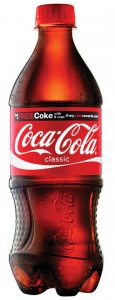
Predictably, beverage makers are up in arms over the bill. The American Beverage Association is lobbying hard to rally opposition against it. They have created an organization called American’s Against Food Taxes and set up the No Beverage Tax website where readers are encouraged to sign a petition against the governor’s proposal. They profess that tax against soda is discriminatory. They imply it is Un-American, harmful to the poor consumer who is overburdened by the recession. Before any tears well up, let’s get real here. We’re talking about making people pay a few cents more for something they shouldn’t be drinking in the first place. Here’s a simple solution for those who feel this causes financial hardship: switch to tap water–it’s free and has no calories!
Make no mistake, sweetened beverages, particularly sodas, are a major threat to public health. These beverages have no nutrient density whatsoever. Zilch! They epitomize the term “empty calories.” Worse, they are digested very quickly into your blood stream, and therefore don’t satisfy hunger—a fact that can lead to overeating. What’s more, they elicit a rapid spike in blood sugar levels, which in itself can lead to excess fat storage as well as increasing sugar cravings. And on top of everything, they’re bad for your teeth, too!
In a recent review of research appearing in the New England Journal of Medicine, Brownell and Frieden (1) reported that consumption of sugary beverages is associated with increases in body weight, poor dietary habits, and an elevated risk of obesity and diabetes. Conversely, a reduced consumption of these beverages has a positive effect on health and wellness. But that’s not the worst of it…
Soft drinks companies focus a great deal of their marketing efforts on children and adolescents, so much so that sugared beverages now comprise 10 to 15% of the calories they consume. It is estimated that each additional glass a child drinks increases his/her likelihood of becoming obese by approximately 60%. Given the epidemic of childhood obesity and its ramifications (approximately one-third of all children in New York State are classified as overweight or obese), this is something that needs to be addressed. Soon!
The real question, then, is whether a soda tax would have any impact on consumption? Evidence suggests it would. Research published in the American Journal of Public Health shows that taxes on cigarettes have substantially curbed the rate of smoking in America (2). What’s more, larger tax increases were associated with larger smoking declines, with the greatest effect seen in youth, minorities, and low-income smokers. This bodes well for the effectiveness of a tax on sugary beverages.
In their article, Brownell and Frieden estimate that for every 10% increase in price, soda consumption decreases by 7.8%. They quote an industry trade publication report that shows even greater price sensitivity: a 12% increase in the price of Coca-Cola resulted in a 14.6% drop in sales. These statistics provide powerful support to the belief that a soda tax would decrease consumption of sugary beverages. If so, this would reduce caloric intake, leading to better weight management for millions of Americans.
An essential aspect of any soda tax is that revenues must go toward offsetting health care costs (the money collected from the proposed tax in New York would be targeted for an existing pool that funds the state’s health expenses). The medical expenses associated with overweight and obesity are staggering. Taxpayers assume the majority of these costs through Medicare and Medicaid. This clearly is unjust. Why should those who watch their diet and maintain their health pay for those who don’t? If a person wishes to consume sugary beverages, that is certainly his right. But he then should be responsible for bearing the costs associated with his decision, not the taxpayers.
Bottom line is that a tax on sodas and other sugary beverages is an idea whose time has come. It will help to make us healthier as a nation, and transfer some of the economic burden of skyrocketing medical costs to those who don’t assume responsibility for their own health. Perhaps the success of such a tax in New York will motivate congress to pass a national tax on sodas and sweetened beverages. And perhaps then, despite the protests from special interest groups, we’ll have a healthier nation because of it.
Stay Fit!
Brad
1) Brownell KD, Frieden TR. Ounces of prevention–the public policy case for taxes on sugared beverages. N Engl J Med. 2009 Apr 30;360(18):1805-8.
2) Peterson DE, Zeger SL, Remington PL, Anderson HA. The effect of state cigarette tax increases on cigarette sales, 1955 to 1988. Am J Public Health. 1992 Jan;82(1):94-6.
January 19, 2010
Flax Oil vs. Fish Oil: Is There a Difference Between the Two?
It’s pretty much common knowledge by now that consumption of fish oil provides a wide range of health-related benefits. These benefits extend to almost every organ system imaginable and include the prevention of numerous disease states. There is even some evidence that fish oil aids in fat loss, helping to keep you lean by simply replacing other fats in the diet on a calorie-for-calorie basis (8). The body of research showing positive effects is so compelling that it seems almost too good to be true.
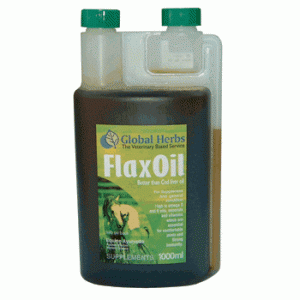
The benefits of fish oil can be traced to two compounds: eicosapentaenoic acid (EPA) and docosahexaenoic acid (DHA). Rather than bore you with technical details as to their mechanisms of action, I’ll just say that EPA and DHA regulate various genes in the body, particularly those involved in inflammatory processes and energy metabolism. The fat in certain fish species act as a storehouse of “preformed” EPA and DHA that is readily used by the human body after consumption. You can obtain these compounds by eating various cold water fish species (such as salmon, mackerel, and sardines), or by consuming fish oil supplements in either liquid or capsule form. Simple enough.
Some people, however, are averse to consuming fish and their oils. Vegetarians, in particular, fall into this category. Others simply don’t care for the taste of fish and find that supplements don’t digest well. So the question then arises whether a vegetable source is available that provides the same benefits as fish oil.
Flaxseed oil is often touted as a vegetable-based alternative to fish oil. Unlike fish oil, flax does not contain preformed EPA or DHA. Rather, it possesses a compound called alpha-linolenic acid (ALA) that can be converted to EPA and DHA in the body. This is where things start to get murky…
In order for conversion of ALA to take place, it must undergo a complex process that further “desaturates” the fatty acid and correspondingly forms longer chain polyunsaturated derivatives. Problem is, research shows that this conversion process is rather inefficient. A review article by Canadian researchers Mélanie Plourde and Stephen Cunnane (7) estimated that only 5% of ALA is converted to EPA and that less than 0.5% of ALA is converted to DHA.
With respect to EPA, the news is not as bad as it sounds. A recent study by Dr. Gwendolyn Barceló-Coblijn (3) and colleagues showed that consumption of 2.4 grams of flax oil increased EPA levels in red blood cells by 1.4-fold — an amount comparable to supplementation with 0.6 grams of fish oil (although less than that found with supplementation of 1.2 grams of fish oil). Similarly, a group of researchers at Emory University led by Dr. Charles Harper (5) found that supplementing with 3 grams of ALA derived from flax oil increased blood levels of EPA by 60%. However, neither study noted any changes in blood levels of DHA. This is significant in that DHA appears to be the more biologically important of the two. DHA is believed to be particularly necessary for brain function, as well as eye health. So the fact that ALA is poorly converted to DHA seemingly makes flax oil a poor substitute for fish oil.
Now before drawing any final conclusions on the matter, a couple of things need to be considered. First, none of the studies evaluated the subject’s consumption of omega-6 fats. Why is this relevant? Well, omega-6 fats compete with omega-3s for desaturation. If there is an abundance of omega-6s in the diet, then conversion of omega-3s will be reduced. And in the Western world, the average ratio of omega-6 to omega-3 is well in excess of 20:1! Thus, it’s possible that if you reduce the ratio to a more palatable 4:1, a greater DHA conversion would be seen.
What’s more, the studies in question looked at the levels of DHA in the plasma and red blood cells — not in specific tissues that require DHA. It is possible that tissues such as the brain, retina, and kidneys use ALA to manufacture DHA as needed, and this would not show up in tests of the blood.
What’s more, it is quite possible that ALA may confer other benefits over and above those found in EPA and DHA. Multiple studies have shown that consumption of ALA itself has cardioprotective effects (2, 4, 6). Further, as noted in the study by Barceló-Coblijn (3), ALA antagonizes the synthesis of arachidonic acid, which is a pro-inflammatory that can negatively impact the body. This alone may possibly aid in preventing various disease states.
Moreover, flax oil contains compounds called lignans that are not present in fish oil. Lignans have been shown to possess antioxidant properties and produce anti-estrogenic effects that may provide a host of additional health-related benefits, including a reduced risk of various cancers (1).
Bottom line: At this point it seems that fish oil probably contains unique properties that are not obtainable in flax. Therefore, until research shows otherwise, flax oil should not be considered a substitute for fish oil. However, flax may provide additional benefits over and above those found in fish oil, and could have an additive effect when the two are consumed in combination.
Stay Fit!
Brad
1. Adolphe JL, Whiting SJ, Juurlink BH, Thorpe LU, Alcorn J. Health effects with consumption of the flax lignan secoisolariciresinol diglucoside. Br J Nutr. :1-10.
2. Ascherio A, Rimm EB, Giovannucci EL, Spiegelman D, Stampfer M, Willett WC. Dietary fat and risk of coronary heart disease in men: cohort follow up study in the United States. BMJ1996;313:84–90.
3. Barceló-Coblijn G, Murphy EJ, Othman R, Moghadasian MH, Kashour T, Friel JK. Flaxseed oil and fish-oil capsule consumption alters human red blood cell n-3 fatty acid composition: a multiple-dosing trial comparing 2 sources of n-3 fatty acid. Am J Clin Nutr. 2008 Sep;88(3):801-9.
4. de Lorgeril M, Renaud S, Mamelle N, et al. Mediterranean alpha-linoleic acid-rich diet in secondary prevention of coronary heart disease. Lancet 1994;343:1454–9.
5. Harper CR, Edwards MJ, DeFilippis AP, Jacobson TA. Flaxseed oil increases the plasma concentrations of cardioprotective (n-3) fatty acids in humans. J Nutr. 2006 Jan;136(1):83-7.
6. Hu FB, Stampfer MJ, Manson JE, et al. Dietary intake of alpha-linoleic acid and risk of fatal ischemic heart disease among women. Am J Clin Nutr1999;69:890–7.
7. Plourde M, Cunnane SC. Extremely limited synthesis of long chain polyunsaturates in adults: implications for their dietary essentiality and use as supplements. Appl Physiol Nutr Metab. 2007 Aug;32(4):619-34
8. Schoenfeld, B. (2004) Omega-3 Fatty Acids: A Novel Fat Burner. Strength and Conditioning Journal, 26(3), 72–76
January 3, 2010
Acai Berry: Help or Hype?
You’ve probably heard the claims about the magical powers of acai berries. Really, how can you avoid them? A Google search of “acai berry” turns up almost 5 million entries, with purported benefits ranging from expediting weight loss, enhancing energy, increasing libido, staving off heart disease, preventing aging, fighting cancer, improving digestion, acting as sleep aid, and alleviating arthritis. Whew! About the only thing the acai hasn’t been credited with yet is curing baldness!
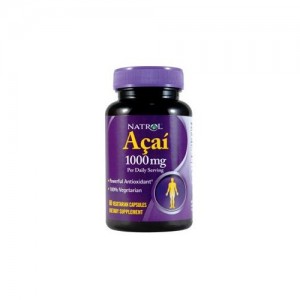
For those who don’t know, the acai is a small, round South American berry that resembles a purple grape when ripe. It gained prominence after a dermatologist, Dr. Nicholas Perricone, tabbed it as a “superfood” on the Oprah Winfrey Show. Ever since, the spam emails with “acai” in the subject heading haven’t stopped flooding my inbox.
Don’t get me wrong, there is little doubt that the acai berry possesses beneficial properties. It’s rich in free-radical quenching antioxidants as well as other vitamins and minerals, and is a fairly good source of fiber. However, so are numerous other darkly colored berries including blackberries, blueberries, and strawberries — all of which are significantly less expensive than acai. And yes, the acai also contains some monounsaturated fats, but the amount is relatively inconsequential — you’d have to eat large quantities just to get the equivalent found in a tablespoon of olive oil.
As for the purported health benefits of the acai berry, a Pubmed search of peer-reviewed research failed to reveal a single study supporting any of the previously mentioned claims. Not one! Bottom line: This is merely another case of unscrupulous hucksters seizing on media-generated publicity with unsubstantiated, hyped-up health-related promises for a product. It’s really no different than the practices of the snake oil salesmen back in the 1800’s — only now the scams are being perpetrated on slickly designed websites rather than from the back of a covered wagon.
To put things in perspective, there certainly is nothing wrong with consuming acai berries as part of your diet. As with most fruits, they provide a good source of nutrients which can help to improve health and well-being. But until research shows otherwise, that’s where the benefits begin and end. Be wary of sham websites selling various acai-based formulas intended to promote weight loss or rejuvenate your body. You’ll only end up disappointed with your results…and lighter in the pocketbook, as well.
Stay Fit!
Brad
December 4, 2009
How Useful is the Glycemic Index?
In recent times, the glycemic index has become a popular tool to help to differentiate ‘good carbs’ from ‘bad carbs.’ Various nutritionists claim it’s the key to a lean body and entire books have been devoted to the subject. But while the glycemic index does have some utility, it isn’t the gold standard some make it out to be. First, a little background: The glycemic index was originally created to help diabetics adjust their insulin dosage. It measures the speed at which carbs enter the blood stream and ranks the foods against a yardstick (usually white bread, which has a glycemic rating of 100). Carbs that cause a rapid elevation of blood sugar (i.e. glucose) are termed high-glycemic, while those that are “time-released” and maintain stable levels of blood sugar are called low-glycemic.

The problem with high-glycemic foods is that they tend to be lipogenic (i.e. fat promoting). A spike in blood sugar levels spike causes your pancreas to release the hormone insulin to clear the sugar from circulation. Unfortunately, insulin is a storage hormone that turns on various fat storage mechanisms and blocks certain enzymes that are responsible for lipolysis (i.e. fat breakdown). When insulin levels are high, excess nutrients are more readily shuttled into adipose cells, resulting in increased levels of body fat.
Furthermore, the rush of insulin clears sugars from your circulatory system in such an expeditious fashion that it creates a rebound effect, producing a sudden and dramatic drop in blood sugar levels. A hypoglycemic state is induced, causing hunger pangs and food cravings. This creates a vicious cycle that encourages binge eating. As a result, more calories are consumed (generally in the form of high-glycemic foods) and fat storage is heightened even further.
However, simply choosing foods with a low glycemic rating won’t necessarily keep you slim and healthy. Understand that food isn’t consumed in a vacuum. A meal generally consists of a combination of different foods (i.e. chicken and rice, turkey on rye, etc) and when fats and proteins are consumed with a carbohydrate, digestion is slowed and the glycemic response is mitigated.
More importantly, the glycemic index fails to distinguish whether or not a food has nutritional value. For example, a carrot has a higher glycemic score than a Snicker’s bar, but there should be little doubt that the carrot is more nutritious. Numerous other items such as doughnuts and ice cream also have low glycemic ratings, yet by no means could they be classified as “healthy” foods. All things considered, it is misguided to solely rely on the glycemic index to guide your choice of carbohydrate.
A better way to choose carbohydrates is by their nutrient density—the amount of vitamins, minerals, and fiber in the food. By nature, nutrient dense carbs will be low on the glycemic scale and thus maintain stable blood sugar levels. But as opposed to some low glycemic foods, they also supply your body with essential compounds that enhance metabolic function. Many of the vitamins and minerals are used as co-factors that assist the body in fat burning. Others serve as antioxidants that keep cells functioning optimally. And fiber promotes satiety, decreasing the urge to overeat.
As a rule, nutrient dense carbs will be unrefined (processing removes much of the vitamins, minerals, and fiber from a food). By sticking with whole grains, and fresh fruit and vegetables for your carbohydrates, you’ll pretty much ensure consuming a low glycemic diet that is replete in healthy nutrients. It’s the best way to eat to attain a lean and healthy physique.
Stay Fit!
Brad
November 1, 2009
Whey vs. Casein: Making Sense of Protein Supplements
Whey vs. casein. Which one is best? I get asked this question on a daily basis. Here’s the scoop…
Both whey and casein are complete protein sources, containing all the essential amino acids. Either one can be used to satisfy your daily protein requirements. And although they are milk-based proteins, most of the lactose is removed during extraction so they shouldn’t pose much of a problem for the lactose intolerant. Just add them to water, juice or whole foods for a power-packed meal.
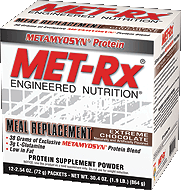
Although whey and casein have similar amino acid profiles, however, there are inherent differences between the two. Perhaps the most relevant difference is that they digest at different speeds. You see, whey is a “fast acting” protein, meaning it’s rapidly absorbed into circulation, generally within about an hour’s time. Casein, on the other hand, is a slow acting protein. It ‘clumps up’ when subjected to stomach acids, dramatically slowing down absorption. So how can you use this information…?
Because it is rapidly assimilated, whey is perfect as a pre and/or post-workout protein source. It reaches your muscles quickly, thereby expediting repair. And since your muscles are primed for anabolism during and after a training session, virtually all of the protein will be utilized for rebuilding with little wastage. In the pre-workout period, aim for about one-tenth of a gram of whey per pound of bodyweight (i.e. a woman weighing 120 pounds would need about 12 grams of whey) while post-workout the amount should be about ¼ gram of protein per pound of bodyweight (the same 120 pound woman would need about 30 grams of whey). Interestingly, some studies indicate that mixing in casein can provide an additive effect on protein synthesis in the post-workout period. This needs further study before conclusions can be drawn.
Conversely, casein is better as a general protein source during ‘non-workout’ periods, either as a meal replacement or simply to meet daily protein requirements. It is particularly good to take before bedtime. During sleep, your body becomes catabolic, breaking down muscle tissue for their amino acids. Since casein takes roughly three to four hours to be fully assimilated, it provides the body with a steady supply of aminos throughout much of the night, significantly limiting protein breakdown. This results in a higher net daily nitrogen balance, leading to better muscle retention.
Remember, though, that taking whey and casein over and above your normal protein requirements won’t do any good from a muscle building standpoint. Unfortunately, protein cannot be stored in your body for future use. When you consume more than what your body can handle (generally about one gram per pound of bodyweight a day), the rest will simply be excreted (or stored as fat, if your calories are in excess of what you expend).
Stay Fit!
Brad
August 25, 2009
Can Meal Replacements Build Muscle?
Just got back from lecturing at CanFitPro (Toronto is a really great city, BTW!), and as always, I got a chance to walk around the trade show and see what was new in fitness retail. One thing stood out to me: in one of the booths, a supplement manufacturer representative was hawking his brand of meal replacement shake as a supreme muscle builder. His pitch: use meal replacements to build better muscles.

Now I’m a big believer in the benefits of meal replacements, specifically for those who have trouble getting adequate nutrition. Essentially, meal replacements are a high protein, low fat, moderate carbohydrate food source that is rich in vitamins and minerals. They are designed to provide a maximal amount of nutrients (nutrient density is perhaps the most important aspect of a healthy diet) in a format that is not inclined to promote significant body fat storage. And best of all, they’re very convenient. Good stuff.
But let’s be clear here, meal replacements will not directly build your muscles or make you stronger. The contention that they have powerful “steroid-like effects” that will somehow miraculously transform your body from fat to fit is nonsense. Not going to happen. Although dietary protein is essential in the muscle building process, simply adding meal replacements to your diet will have no effect on building better muscles. And provided you get adequate protein from your diet, consuming extra protein is superfluous: any excess beyond what your body can use is simply excreted (or in the case where there is a caloric excess, stored as fat).
As a general rule, meal replacements are best utilized as an adjunct to a well-balanced nutritional regimen—not as a substitute for natural foods. They fill a specific dietary niche, but by no means are a complete source of nutrition. If you find it difficult to prepare meals and/or get adequate protein in your diet, combining meal replacements with natural foods is the best way to satisfy all of your nutritional requirements, ensuring an optimal intake of nutrients.
If you choose to use meal replacements, it is best to eat a hearty breakfast, lunch and dinner, using shakes as “interim” meals. On occasion, you can swap a meal replacement for whole foods if you simply don’t have time to prepare a meal. It is widely recognized that a diet consisting of small, frequent meals (five a day) spaced out every three hours or so provides optimal nutritional utility. Eating in this fashion helps to optimally regulate blood sugar levels and stabilize various hormonal processes, allowing your body to operate at peak efficiency. Furthermore, it helps to suppress hunger and thus prevent the temptation to snack on “empty calorie” foods that are high in saturated fat and sugars. Since meal replacements are convenient and easy to prepare, they facilitate your ability to consume quality nutrients at regular intervals without expending a great deal of effort. Just don’t expect to get buff from a shake!
Stay Fit!
Brad
June 20, 2009
Bad Food of the Week: Pam Professional High Heat
Non-stick cooking sprays can be a beneficial cooking aid. They can help to evenly coat a frying pan with healthy oils, ensuring you don’t overdo it from a caloric standpoint. In theory, this makes for a healthful food source.

What many fail to realize is that oils have “smoke points.” If you exceed the smoke point of an oil, it will become rancid, breaking down the double bond structure of the oil and potentially turning it into a carcinogen. To address this fact, PAM has come out with a cooking spray called PAM Professional High Heat (apparently originally designed for professional chefs). PAM Professional High Heat is formulated so that you can cook at high temperatures without the oil smoking, and avoid the associated blackened pans and residue build up. Sounds good, right? Not so fast…
Take a look at the ingredients. The first ingredient listed: Vegetable Oil (Partially Hydrogenated Soybean Oil*, Canola Oil*). Any time you see the word “partially hydrogenated” it means that the oil is a trans fat. Sure, trans fats are resistant to high heat–but they are also one of the biggest nutritional detriments to your health and well and being.
An examination of the listed ingredients on the label claims only a negligible level of trans fats (0.1 g). Upon closer inspection, however, this is deceiving. Values are based on a .4 second spray. That’s 4/10 of a second! Who coats a frying pan with a spray lasting less than half a second? No one I know. A two second spray would be more realistic, in which case you’re already up to half a gram of trans fats. It certainly wouldn’t be unusual to spray for five seconds or more to fully coat a pan. If so, you’re well over a gram of artery-clogging, cancer-causing trans fats. Don’t be fooled, they add up quickly.
Bottom line: stay away from any product that contains “partially hydrogenated” in the ingredients. They are one of the biggest–if not the biggest–food-based impediments to your health.
Stay Fit!
Brad
June 2, 2009
Diet for a Flat Belly?
Recently, one of my students presented me with a copy of a book called, “The Flat Belly Diet.” A catchy title, no doubt. After all, who wouldn’t be enticed by a diet that claims to selectively target the fat around your midsection and flatten your stomach by simply eating certain foods?
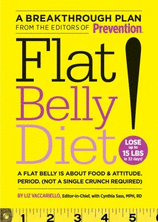 The concept of the “Flat Belly Diet” is fairly simple. Basically, it professes that in order to lose your gut you need to eat a diet rich in monounsaturated fats (MUFAs)–a type of fat found in olive oil, avocados, and certain nuts. The impetus for this theory was derived from a study in the journal Diabetes Care, which showed that a MUFA-rich diet tended to reduce abdominal fat stores to a greater degree than those who ate a high-carb diet. While on the surface this might seem like a ground-breaking discovery, several things need to be kept in mind. First off, the sample size of the study consisted of only 11 subjects–a very small number for a study of this scope. What’s more, the subjects were all Type II diabetics. It’s purely speculative as to whether similar results would be realized in those who aren’t diabetic (and logic would lead me to believe that many wouldn’t). There also was no mention as to the types of carbs consumed by the subjects. There is a BIG difference between eating a bowl of oatmeal vs. a bowl of Frosted Flakes, despite the fact that both are largely carbohydrate based. Yet this wasn’t addressed anywhere in the study.
The concept of the “Flat Belly Diet” is fairly simple. Basically, it professes that in order to lose your gut you need to eat a diet rich in monounsaturated fats (MUFAs)–a type of fat found in olive oil, avocados, and certain nuts. The impetus for this theory was derived from a study in the journal Diabetes Care, which showed that a MUFA-rich diet tended to reduce abdominal fat stores to a greater degree than those who ate a high-carb diet. While on the surface this might seem like a ground-breaking discovery, several things need to be kept in mind. First off, the sample size of the study consisted of only 11 subjects–a very small number for a study of this scope. What’s more, the subjects were all Type II diabetics. It’s purely speculative as to whether similar results would be realized in those who aren’t diabetic (and logic would lead me to believe that many wouldn’t). There also was no mention as to the types of carbs consumed by the subjects. There is a BIG difference between eating a bowl of oatmeal vs. a bowl of Frosted Flakes, despite the fact that both are largely carbohydrate based. Yet this wasn’t addressed anywhere in the study.
Now I have no qualms with recommending a diet that is rich in MUFA’s. They’ve been shown to be heart healthy and have beneficial metabolic effects. Specifically, when compared to saturated fats, consumption of MUFAs have been shown to result in less fat accumulation, even when caloric intake is similar. But MUFAs aren’t the only type of fat that confers such benefits. Omega 3 fats–a polyunsaturated fatty acid–show similar metabolic efficiencies as well as having a positive impact on numerous aspects of health and wellness. Given that omega-3s are “essential” fats (meaning the body can’t produce them naturally and that an absence causes disease), they are unquestionably a more important dietary nutrient than MUFAs. Yet there is little mention of omega-3s in the “Flat Belly Diet”.
Perhaps the biggest failing of the book is that it doesn’t focus on the most important nutrient for fat loss: protein. Protein confers numerous metabolic advantages for those seeking to optimize body composition. First, it increases satiety. Studies have clearly shown that when you eat higher amounts of protein, your appetite decreases, causing you to eat less food. Reduce calories and you lose weight, pure and simple. More importantly, a higher protein intake helps to preserve lean muscle while dieting. It has been well documented that if protein intake isn’t maintained when calories are restricted, people lose considerable muscle mass. The significance here is that muscle is metabolically active tissue. Lose muscle and your metabolism slows to an eventual crawl. You end up hitting a weigh loss plateau and ultimately you gain back what you lost and more.
Bottom line: There is nothing magical about the “Flat Belly Diet.” Don’t expect to go on this diet (or any diet, for that matter), and expect to selectively slim down your waistline. Proper nutrition during dieting requires sufficient protein to attenuate muscle loss (generally around 2 grams of protein per kilogram of body weight). And while monounsaturated fats are certainly beneficial, it’s more important to focus on increasing the amount of omega-3 fats in your diet. In addition to being highly bio-active, they have proven to confer numerous health and wellness benefits in ways that no other dietary fat can.
As always, be an educated consumer don’t fall for the hype.
Stay Fit!
Brad





 Entries (RSS)
Entries (RSS)



